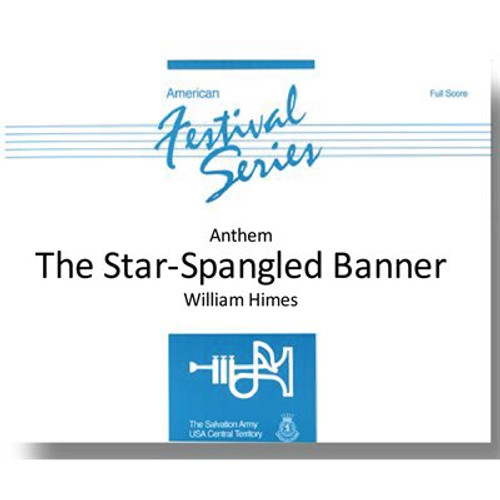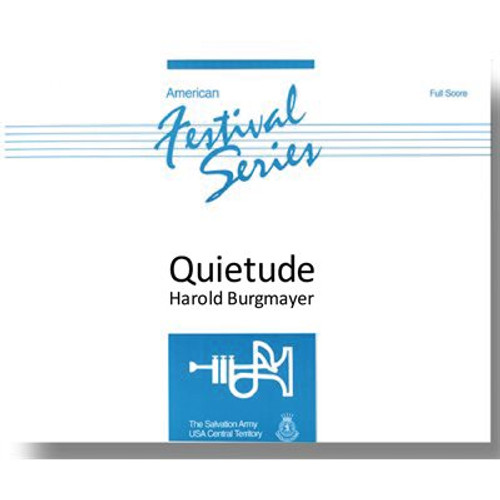Product Description
The Star-Spangled Banner
Anthem
Arranger: William Himes, USA Central Territory
Produced by The Salvation Army - Central Territory
Score Sample
Notes
Account -> Orders -> Select order number
Score Notes
Notes:
Comments by Staff Bandmaster William Himes, Music & Gospel Arts Secretary, USA Central TerritoryWhile it would be futile to attempt to outdo Erik Leidz��n's classic setting of the American national anthem published forty years ago in the American Band Journal (USA Eastern Territory, New York), it was felt that a new arrangement with the expanded scoring format of the Festival Series could provide added usefulness and interest to this patriotic melody.?In fact, the approach to this setting could best be described as "text painting," wherein the mood of the music mirrors the feelings of the text. Hence, the stormy (and optional) introduction quickly gives way to the tentative uncertainty of the opening lines, which pose questions in the aftermath of battle. (Roughly paraphrased, "Can you see how it ended? Did we win? Is our flag still there?")?Memories of the fierce conflict are recounted and portrayed in the middle section ("And the rockets' red glare, the bombs bursting in air..") symbolized with soaring runs coming up from basses through cornets, followed by the accented motifs of combat.?At the risk of stating the obvious, in spite of all the musical fireworks, the tune must be at the fore throughout.
Program Note:
This colorful selection uses three songs of contrasting idiom to portray a progression of the human condition from despair to triumph:
Although this is a more extended work (approximate duration: 9:00), the inclusion of optional introductions and endings provides added usefulness of presenting singular performances of these three songs as follows:
Sometimes I feel like a motherless child: Beginning to optional ending at bars 39-40.
Reach out and touch: Bar 42 to optional ending at bars 110-113.
Storm the forts of darkness: Begin with snare drum roll (can be a pause) one beat before 117. Play to end as written.
Program Note:
This beautiful setting for solo trombones and band of the folk song O Waly, O Waly is often associated with the words of Isaac Watts:Note to the Conductor:
We are pleased to present this sensitive setting as it was initially conceived for solo trombone. Written for the Amsterdam Staff Band's 2005 tour of the United Kingdom, it was later adapted as a feature for trombone ensemble, at the request of Salvationist Publishing & Supplies, where it appears in 2009 as General Series 2059.
We are grateful to SP&S for kindly giving permission to publish this solo version in the American Festival Series. Of this work, the arranger, Olaf Ritman writes: "I consider this song my personal testimony."
Beginning to bar 12: The accompaniment, particularly at the opening and closing of the piece, is atmospheric, with suspended muted chords supporting the rubato trombone solo. The judicious use of percussion (chimes, bass drum and suspended cymbal) will add to the color and mood. Be sure to cue the chimes at bars 3 and 6.
at bar 4, a clear downbeat cure for the bass drum will help clarify tempo following the soloist's pause. Also give attention to the muted sforzando in cornets and trombones in bar 8.
Bars 13-52: Following the ritardando at bar 12, it is essential for the conductor to establish the correct tempo at bar 13, allowing the soloist lyrical freedom and the ability to sustain long phrases as the tune begins at bar 16. The descending scale gesture at bar 39 should be measured, yet not overstated.
Bars 53-74: There is a slight slowing of tempo as soprano, flugel and horns take the theme while cornets, trombones and euphonium adding countermelody.
Bars 75 to end: Returning to the opening tempo, it will again be helpful to give clear cues for the chimes, bass drum and triangle from bars 75 to the end.
[Note: This solo can be heard on the Chicago Staff Band recording,Kurios, performed by Brett Tolcher]
Program Note:
The tune Randolph, by preeminent English composer Ralph Vaughan Williams was first published in 1906 as a setting of Jeremiah Rankin's hymn, of which the first verse reads:
Note to the Conductor:
William Gordon's stunning four verse setting of Randolph progresses from the quiet simplicity of unison cornets and with each succeeding verse builds to a magnificent organ-like finale.
Gratitude is expressed to the publisher and copyright holder, Oxford University Press, for granting permission to publish this brass setting in the American Festival Series.
Beginning to bar 9: A ceremonial snare drum roll is the sole accompaniment to the cornets opening unison rendering of the tune.
Bar 10-17: The mellow instruments (flugel, horns, baritones and euphoniums) provide a beautiful change of color here with 2nd horn, baritones and euphonium seamlessly adding harmony.
Bars 18-26: A two beat snare and bass drum roll signals the entrance of the cornets and trombones in a more brilliant third verse setting. Here the bass trombone is essential (cued in Eb bass). Bring out the rising soprano cornet line from bar 22.
Bar 27 to end: A dramatic percussion roll precedes the "open pipes" organ like sounds of the final verse at bar 27. Be sure to observe the swell in bar 30, followed by a dramatic decrescendo before building to the final climatic chords. Avoid any tendency to overblow while striving for the full sonorities of this majestic finale.
[Note: this setting is especially effective when performed as a benediction "in the round" with players grouped by sections surrounding the audience.]







